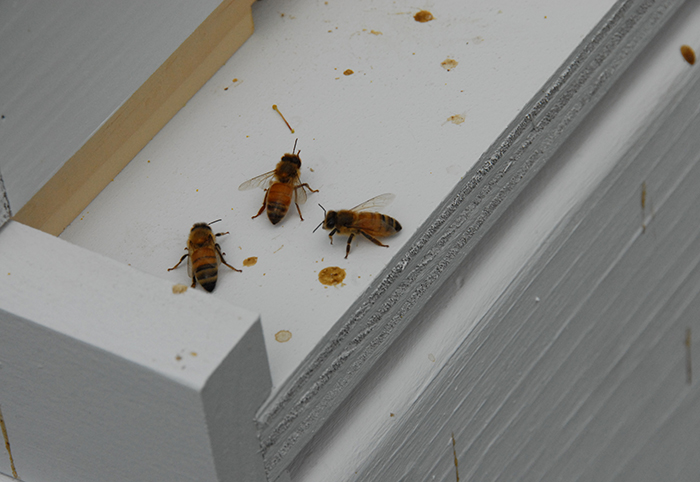 It was one of those off-the-cuff ideas that had Elizabethtown College Dining Services buzzing this spring.
It was one of those off-the-cuff ideas that had Elizabethtown College Dining Services buzzing this spring.
“Charlie saw something in the Merchandiser about a free beekeeping class,” said Eric Turzai, director of Dining Services. He was referencing Charlie Downs, residential dining chef, and a six-hour introduction to the habits and lives of the fuzzy little honey producers.
“We were amazed at what bees do and the reasons for them,” Turzai said, after he and Downs took the class last February. But they sort of forgot about the bees until another coworker, Chris Bowers, attended this winter’s class.
Their interests were piqued anew.
After some discussion and budget checks, Turzai ordered the bees—$100—from California. They were shipped to the closest location—two hours north in Wilkes-Barre—where he picked them up at the end of April to bring to campus.
“There I was, driving my Suburban with five containers of 3,000 bees,” he said laughing. Luckily the cooler temperatures that day kept the flying insects fairly mellow.
We were amazed at what bees do and the reasons for them.”
Each of the wooden boxes contained not only bees but also a can of sugar water to keep them fed and a small box containing their queen. Four of the containers were temporary home to an Italian race, apis mellifera ligustica, the most popular bee in North America. They are gentle, high in honey production and are all-around excellent bees, but they tend toward robbing and drifting—stealing honey from neighboring colonies or moving to alternate locations—Turzai said. The fifth container transported the Carniolan race or apis mellifera carnica, a darker bee that thrives in more northern climes. Though they fly in cooler weather, they are a bit less productive.
 For Elizabethtown, however, the production isn’t the highest concern. Keeping bees also is intended as a means to help pollinate the College garden and to add to academic opportunities.
For Elizabethtown, however, the production isn’t the highest concern. Keeping bees also is intended as a means to help pollinate the College garden and to add to academic opportunities.
The hives—wooden containers with a small opening at the bottom and several drawers for laying eggs and honey production—were placed along the path to Bowers Writers House. They sit up high on wooden stilts that were manufactured by student group FEAST (Future Energies and Sustainable Technologies Club) and are facing southeast to get the most sun.
The queens were placed first in the lowest box of each hive. The corks in their containers were replaced with small marshmallows so the drones and workers, when introduced, could chew through the sugary ball to release their queens.
In each hive are several drawers for eggs and honey. There also is a plastic insert that looks like honeycomb “to help the bees get things started,” said Turzai.
Once the 15,000 bees were transferred and sugar water was added to a feeder on the front of the hives, the humans backed away. Their work was pretty much finished.
Amazingly, less than 1 percent of the bees were lost in transport. Just a few bodies were seen lifeless in the bottom of the wooden trasport boxes. “It was pretty cold when we put them in,” Turzai said, noting that the flying insects huddled around their queen who prefers temperatures around 98 degrees.
 Soon, though, they began their search for nectar, flying around the area to visit flowering trees and plants. Their search covers approximately a two-mile radius of the hive. Sugar water—a jar a day—is given to the bees to supplement their nutrition until the colony is settled.
Soon, though, they began their search for nectar, flying around the area to visit flowering trees and plants. Their search covers approximately a two-mile radius of the hive. Sugar water—a jar a day—is given to the bees to supplement their nutrition until the colony is settled.
Those colonies are made up of the queen, her female workers and male drones. When one of the workers finds nectar, Turzai said, she comes back to the hive and performs a waggle dance or an intricate pattern of movements that shows the other bees where the nectar is located. Her movements communicate to the others where the nectar is in reference to the location of the hive and the position of the sun. She also shares the distance.
“We most likely won’t gather any this year,” he said of the honey, pointing out that the bees need to be sustained through the winter. But, next year, around July, Elizabethtown honey should be plentiful. “Depending on how much we get we might sell it retail,” Turzai said.
For an added bonus, as the bees gather the nectar to make honey, they also transfer pollen on their fuzzy bodies and legs, which is how they help the College garden. The garden, in turn, generates fresh produce for use in dining services and for sale in the Jay’s Nest throughout the late spring and summer.
“With the decline in the honeybee population, we thought it would be not only fun but educational,” said Turzai, who hopes academic departments use the bees and hives to teach about sustainability. “It’s all about the colony and it’s all about the queen.”
Though, a week later, the hives are still buzzing, it’s not a guarantee that the transfer was successful. Unfortunately, Turzai said, the queen and, therefore, the bees, aren’t guaranteed to stay where their host placed them. “We could lose a colony,” he said.
But, if all goes well, honey production should be taking place as you read these words.

